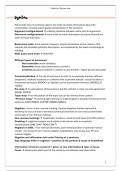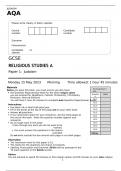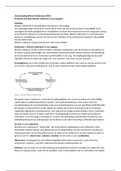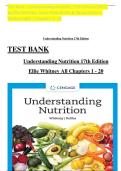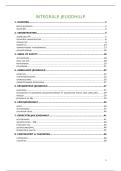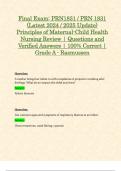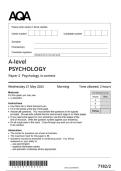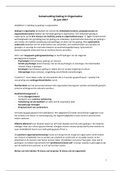Made by: Daryan vdw
Syntax
Word order has a functional aspect, the order provides information about the
combination of words which guide interpretation of the sentence
Argument configurational à ordering relations between verbs and its arguments
Discourse configurational à word order to mark information structure distinctions
such as focus and topic
Basic word order: most neutral, frequent, simple declarative active clauses, that
requires the simplest syntactic description, accompanied by the least morphological
marking
SASL basic word order à SOV/OSV
Different types of sentences:
Non-reversible (more variation)
Reversible (basic word order more common)
Locatives (positions entities in relation to one another – figure-ground principle)
Pronominalization à the use of a pronoun to refer to a previously mention referent
(anaphoric- arbitrary location) or a referent that is present (deictic- actual location) =
first person pronouns (INDEX1) or Spatial Loci for pronominal reference (INDEX2,3/
1ASK3)
Pro-drop à no articulation of the pronoun but the referent is clear via verb agreement
(BOOK 1GIVE3)
Topic-drop à no articulation of the topic but can be inferred from context
“Pronoun Copy” à pointing sign referring to subject/agent is already mentioned in the
sentence (MAN INDEX3 COFFEE ORDER INDEX3)
Negation = form of non-manual marking, manual negation marker (optional &
tendency to occur at end of sentence) (manual dominate or non-manual dominate)
and scope of non-manual marking
Non-manual markings à headshake, headturn, head-tilt and head-nod (affirmation)
Doubling à negative markers are doubled in structures with an emphatic
interpretation (ANN CAN’T READ CAN’T)
Negation in SASL = non-manual dominate, post-verbal position of optional manual
marker, min scope of non-manual negator (headshake), max scope over VP and
manual negator
Negation and affirmation fall under Polarity of a sentence
Sign language differ in negation = position of the particle & scope of headshake
Information structure consist of = given vs new information & topic vs focus
Focus à determines which part of the sentence contributes new information
1
, Made by: Daryan vdw
Information focus à the part of the utterance that introduces new information
into the discourse (answer to wh-question – INDEX1 READ ROMANCE BOOKS)
Contrastive focus à one or more alternatives to the focused expression (JOHN
NOT-LIKE MARY, JANE INDEX3 LOVE)
Emphatic focus à sentence describes something unexpected (MUST GO-
WORK MUST)
Topic à what is being talked about, give information (sentence-initial position)
Topicalization à grammatical operation where the tropicalized constituent is placed
at the being of the sentence (non-manual marker of “top” or “t”
Two types = non-tropicalized part can stand on its own or topicalized part is
an integral part of the sentence ___top
Topics can be based-generated (MARY, JOHN LIKE INDEX3)
Topics can be moved from an argument position (MARY, JOHN LOVE)
Adjuncts can also occur in topic position (TOMORROW, JOHN PLACE ARRIVE)
Sentence types:
Interrogatives (Yes/No questions – question particle & wh-questions “wh” &
furrowed eyebrows, question sign & wh-doubling & sentence final-position)
Imperatives (commands vs requests & tense articulation “NOW!” & headnod)
Indirect speech vs direct speech in SL is done via role shift via non-manual
markers (body shift)
Types of Complex sentences:
1.Coordination à combination of several main clauses
§ Conjuncts can occur independently
§ Use of manual conjunctions & body leans
§ Ellipsis – omit elements that occur in both conjuncts
§ Adversative (contrast), conjunctive (connect) & disjunctive (choice)
2.Subordination à main clause and an embedded clause (such as Complement
clause, Adverbial clause & Relative clause)
§ Complement clause à embedded clause is obligatory part of sentence
o often the constituent order in a complement clause has the same order
in a main clause thus it is difficult to differentiate between the main
clause and the embedded clause (“set apart” via non-manual marking or
intonation breaks) – verb is usually in final position (SOV) but complement
clause follows verb in main clause (extraposition)
§ Adverbial clause à embedded clause is optional, specifies certain
circumstance and details of an event (time, location, purpose, conditions)
o Temporal clauses (adverbs, NP, PP) – eyebrow raise & pause (,) & always
at beginning
o Casual /purpose clause (directed causal conjunction – BECAUSE &
REASON)
§ Pseudo cleft (express focus i.e. new info)
2
Syntax
Word order has a functional aspect, the order provides information about the
combination of words which guide interpretation of the sentence
Argument configurational à ordering relations between verbs and its arguments
Discourse configurational à word order to mark information structure distinctions
such as focus and topic
Basic word order: most neutral, frequent, simple declarative active clauses, that
requires the simplest syntactic description, accompanied by the least morphological
marking
SASL basic word order à SOV/OSV
Different types of sentences:
Non-reversible (more variation)
Reversible (basic word order more common)
Locatives (positions entities in relation to one another – figure-ground principle)
Pronominalization à the use of a pronoun to refer to a previously mention referent
(anaphoric- arbitrary location) or a referent that is present (deictic- actual location) =
first person pronouns (INDEX1) or Spatial Loci for pronominal reference (INDEX2,3/
1ASK3)
Pro-drop à no articulation of the pronoun but the referent is clear via verb agreement
(BOOK 1GIVE3)
Topic-drop à no articulation of the topic but can be inferred from context
“Pronoun Copy” à pointing sign referring to subject/agent is already mentioned in the
sentence (MAN INDEX3 COFFEE ORDER INDEX3)
Negation = form of non-manual marking, manual negation marker (optional &
tendency to occur at end of sentence) (manual dominate or non-manual dominate)
and scope of non-manual marking
Non-manual markings à headshake, headturn, head-tilt and head-nod (affirmation)
Doubling à negative markers are doubled in structures with an emphatic
interpretation (ANN CAN’T READ CAN’T)
Negation in SASL = non-manual dominate, post-verbal position of optional manual
marker, min scope of non-manual negator (headshake), max scope over VP and
manual negator
Negation and affirmation fall under Polarity of a sentence
Sign language differ in negation = position of the particle & scope of headshake
Information structure consist of = given vs new information & topic vs focus
Focus à determines which part of the sentence contributes new information
1
, Made by: Daryan vdw
Information focus à the part of the utterance that introduces new information
into the discourse (answer to wh-question – INDEX1 READ ROMANCE BOOKS)
Contrastive focus à one or more alternatives to the focused expression (JOHN
NOT-LIKE MARY, JANE INDEX3 LOVE)
Emphatic focus à sentence describes something unexpected (MUST GO-
WORK MUST)
Topic à what is being talked about, give information (sentence-initial position)
Topicalization à grammatical operation where the tropicalized constituent is placed
at the being of the sentence (non-manual marker of “top” or “t”
Two types = non-tropicalized part can stand on its own or topicalized part is
an integral part of the sentence ___top
Topics can be based-generated (MARY, JOHN LIKE INDEX3)
Topics can be moved from an argument position (MARY, JOHN LOVE)
Adjuncts can also occur in topic position (TOMORROW, JOHN PLACE ARRIVE)
Sentence types:
Interrogatives (Yes/No questions – question particle & wh-questions “wh” &
furrowed eyebrows, question sign & wh-doubling & sentence final-position)
Imperatives (commands vs requests & tense articulation “NOW!” & headnod)
Indirect speech vs direct speech in SL is done via role shift via non-manual
markers (body shift)
Types of Complex sentences:
1.Coordination à combination of several main clauses
§ Conjuncts can occur independently
§ Use of manual conjunctions & body leans
§ Ellipsis – omit elements that occur in both conjuncts
§ Adversative (contrast), conjunctive (connect) & disjunctive (choice)
2.Subordination à main clause and an embedded clause (such as Complement
clause, Adverbial clause & Relative clause)
§ Complement clause à embedded clause is obligatory part of sentence
o often the constituent order in a complement clause has the same order
in a main clause thus it is difficult to differentiate between the main
clause and the embedded clause (“set apart” via non-manual marking or
intonation breaks) – verb is usually in final position (SOV) but complement
clause follows verb in main clause (extraposition)
§ Adverbial clause à embedded clause is optional, specifies certain
circumstance and details of an event (time, location, purpose, conditions)
o Temporal clauses (adverbs, NP, PP) – eyebrow raise & pause (,) & always
at beginning
o Casual /purpose clause (directed causal conjunction – BECAUSE &
REASON)
§ Pseudo cleft (express focus i.e. new info)
2

